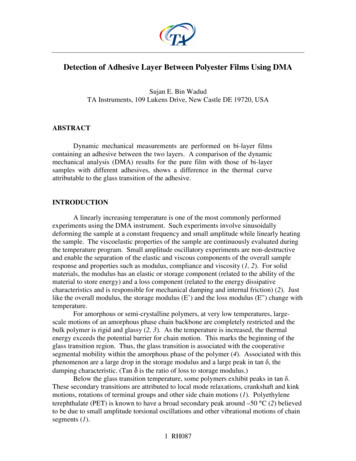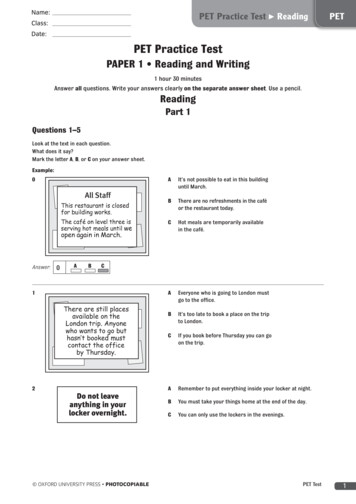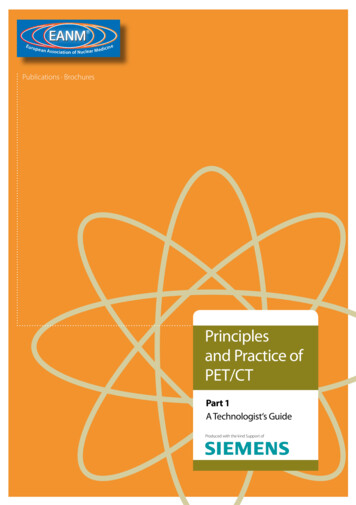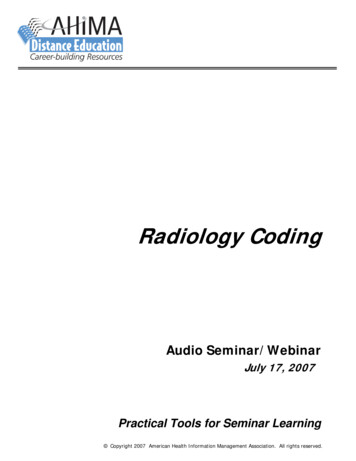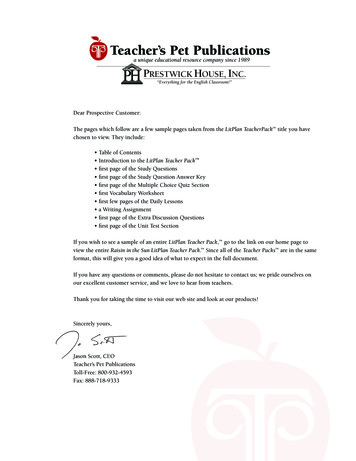
Transcription
Teacher’sPet Publicationsa unique educational resource company since 1989Dear Prospective Customer:The pages which follow are a few sample pages taken from the LitPlan TeacherPack title you havechosen to view. They include: Table of Contents Introduction to the LitPlan Teacher Pack first page of the Study Questions first page of the Study Question Answer Key first page of the Multiple Choice Quiz Section first Vocabulary Worksheet first few pages of the Daily Lessons a Writing Assignment first page of the Extra Discussion Questions first page of the Unit Test SectionIf you wish to see a sample of an entire LitPlan Teacher Pack, go to the link on our home page toview the entire Raisin in the Sun LitPlan Teacher Pack. Since all of the Teacher Packs are in the sameformat, this will give you a good idea of what to expect in the full document.If you have any questions or comments, please do not hesitate to contact us; we pride ourselves onour excellent customer service, and we love to hear from teachers.Thank you for taking the time to visit our web site and look at our products!Sincerely yours,Jason Scott, CEOTeacher’s Pet PublicationsToll-Free: 800-932-4593Fax: 888-718-9333
TEACHER’S PET PUBLICATIONSLITPLAN TEACHER PACK forFarewell to Manzanarbased on the book byJeanne Wakatsuki Houston & James D. HoustonWritten byBarbara M. Linde, MA Ed. 2004 Teacher’s Pet PublicationsAll Rights ReservedISBN 978-1-60249-162-5Item No. 304433
This Lit Plan on Farewell to Manzanar has been brought to youby Teacher’s Pet Publications, Inc.Copyright Teacher’s Pet Publications 2004All Rights ReservedOnly the student materials in this unit plan may be reproduced.Pages such as worksheets and study guides may be reproducedfor use in the purchaser’s classroom.For any additional copyright questions, contact Teacher’s Pet Publications.www.tpet.com
TABLE OF CONTENTS – Farewell to ManzanarIntroductionUnit ObjectivesReading Assignment SheetUnit OutlineStudy QuestionsQuiz/Study Questions (Multiple Choice)Pre-Reading Vocabulary WorksheetsLesson One (Introductory Lesson)Nonfiction Assignment SheetOral Reading Evaluation FormWriting Assignment 1Writing Evaluation FormWriting Assignment 2Extra Writing Assignments/Discussion QuestionsWriting Assignment 3Vocabulary Review ActivitiesUnit Review ActivitiesUnit TestsUnit Resource MaterialsVocabulary Resource 3
A FEW NOTES ABOUT THE AUTHORJEANNE WAKATSUKI HOUSTONHOUSTON, Jeanne (Toyo) Wakatsuki (1934--) Jeanne (Toyo) Wakatsuki was born onSeptember 26, 1934 in Inglewood, California. Her father, Ko, was born in Hiroshima, Japan and was afirst-generation Japanese immigrant to America. Her mother, Riku was born in Hawaii and was asecond generation Japanese-American. Jeanne was the youngest of the children. She had five oldersisters and four older brothers.The Wakatsuki family was part of the 110,000 Japanese Americans who were interned in relocationcamps during World War II. Farewell to Manzanar, written in 1973 by Jeanne and her husband,James Houston, is the story of her family’s time at the camp. After being released from the camp in1945, Jeanne moved back to the Los Angeles area with her parents and some of her siblings. Shestudied sociology and journalism at San Jose State College in San Jose, California. She met JamesHouston while in college and married him in 1957.In 1971 one of her nephews asked Jeanne for details about Manzanar, as he had been born there butdid not have many memories of the experience. In 1972, thirty years after leaving Manzanar, Jeannereturned to the Manzanar campsite with her husband and three daughters. This visit helped her come toterms with what had happened to her and her family. Jeanne and her husband began writing Farewellto Manzanar together. She documents the return visit in the last chapter of the book.Jeanne Wakatsuki Houston continues to write and lecture on her works and her life experiences. Shelives in Santa Cruz, California, with her family. Her other books are The Legend of Fire HorseWoman, Beyond Manzanar, and Don’t Cry, It’s Only Thunder. Along with her husband, she wrotethe screenplay for the film version of Farewell to Manzanar. This was a made-for-TV movie that wasshown in 1976. The couple’s twin daughters appeared in the movie. The screenplay won theChristopher Award and the Humanities Prize. In 1984 she received the National Women’s PoliticalCaucus award and the Wonder woman award.HOUSTON, James D. (1933 --) James Houston was born in San Francisco, California, in1933. He met Jeanne Wakatsuki while attending San Jose State College, and married her in 1957. Hehas taught at the University of California at Santa Cruz and at Stanford University. Houston’s otherbooks include A Native Son of the Golden West, Continental Drift, and In the Ring of Fire. Hehas been awarded the Wallace Stenger Writing Fellowship at Stanford University and has won theJoseph Henry Jackson Award for Fiction and other awards.4
INTRODUCTION - Farewell to ManzanarThis unit has been designed to develop students’ reading, writing, thinking, listening, and speaking skillsthrough exercises and activities related to Farewell to Manzanar by Jeanne Wakatsuki Houston Itincludes 20 lessons, supported by extra resource materials.The introductory lesson introduces students to Farewell to Manzanar. Following the introductoryactivity, students are given an explanation of how the activity relates to the book they are about to read.Following the transition, students are given the materials they will be using during the unit. They are alsointroduced to the nonfiction assignment. At the end of the lesson, students begin the pre-reading workfor the first reading assignment.The reading assignments are approximately 30 pages each; some are a little shorter while others area little longer. Students have approximately 15 minutes of pre-reading work to do prior to each readingassignment. This pre-reading work involves reviewing the study questions for the assignment and doingsome vocabulary work for 8 to 10 vocabulary words they will encounter in their reading.The study guide questions are fact-based questions; students can find the answers to these questionsright in the text. These questions come in two formats: short answer or multiple choice. The best use ofthese materials is probably to use the short answer version of the questions as study guides for students(since answers will be more complete), and to use the multiple-choice version for occasional quizzes. Itmight be a good idea to make transparencies of your answer keys for the overhead projector.The vocabulary work is intended to enrich students’ vocabularies as well as to aid in the students’understanding of the book. Prior to each reading assignment, students will complete a two-partworksheet for approximately 8 to 10 vocabulary words in the upcoming reading assignment. Part Ifocuses on students’ use of general knowledge and contextual clues by giving the sentence in which theword appears in the text. Students are then to write down what they think the words mean based on thewords’ usage. Part II gives students dictionary definitions of the words and has them match the wordsto the correct definitions based on the words’ contextual usage. Students should then have anunderstanding of the words when they meet them in the text.After each reading assignment, students will go back and formulate answers for the study guidequestions. Discussion of these questions serves as a review of the most important events and ideaspresented in the reading assignments.After students complete extra discussion questions, there is a vocabulary review lesson which pullstogether all of the separate vocabulary lists for the reading assignments and gives students a review ofall of the words they have studied.5
Following the reading of the book, two lessons are devoted to the extra discussion questions/writingassignments. These questions focus on interpretation, critical analysis and personal response,employing a variety of thinking skills and adding to the students’ understanding of the novel. Thesequestions are done as a group activity.Using the information they have acquired so far through individual work and class discussions, studentsget together to further examine the text and to brainstorm ideas relating to the themes of the novel.The group activity is followed by a reports and discussion session in which the groups share theirideas about the book with the entire class; thus, the entire class gets exposed to many different ideasregarding the themes and events of the book.There are three writing assignments in this unit, each with the purpose of informing, persuading, orhaving students express personal opinions. The first assignment is to inform. Students will write anewspaper article related to the internment of the Japanese-Americans. The second writing assignmentis to persuade. Students will write a letter to a government official explaining why the JapaneseAmericans should be released from the internment camps. The third writing assignment is to offer apersonal opinion. Students will take the role of a friend of Jeanne’s in junior high or high school andtell other students how Jeanne should be treated. .In addition, there is a nonfiction reading assignment. Students are required to read a piece ofnonfiction related in some way to Farewell to Manzanar. After reading their nonfiction pieces,students will fill out a worksheet on which they answer questions regarding facts, interpretation,criticism, and personal opinions. During one class period, students make oral presentations about thenonfiction pieces they have read. This not only exposes all students to a wealth of information; it alsogives students the opportunity to practice public speaking.The review lesson pulls together all of the aspects of the unit. The teacher is given four or five choicesof activities or games to use which all serve the same basic function of reviewing all of the informationpresented in the unit.The unit test comes in two formats: all multiple choice matching true/false or with a mixture ofmatching, short answer, and composition. As a convenience, two different tests for each format havebeen included.There are additional support materials included with this unit. The resource materials sectionsinclude suggestions for an in-class library, crossword and word search puzzles related to the novel, andextra vocabulary worksheets. There is a list of bulletin board ideas which gives the teachersuggestions for bulletin boards to go along with this unit. In addition, there is a list of extra classactivities the teacher could choose from to enhance the unit or as a substitution for an exercise theteacher might feel is inappropriate for his/her class. Answer keys are located directly after thereproducible student materials throughout the unit.6
UNIT PLAN ADAPTATIONS - Farewell to ManzanarBlock ScheduleDepending on the length of your class periods, and the frequency with which the class meets,you may wish to choose one of the following options: Complete two of the daily lessons in one class period. Have students complete all reading and writing activities in class. Assign all reading to be completed out of class, and concentrate on the worksheets anddiscussions in class. Assign the projects from Daily Lesson Fifteen at the beginning of the unit, and allowtime each day for students to work on them. Use some of the Unit and Vocabulary Resource activities during every class.Gifted & Talented / Advanced Classes Emphasize the projects and the extra discussion questions. Have students complete all of the writing activities. Assign the reading to be completed out of class and focus on the discussions in class. Encourage students to develop their own questions.ESL / ELD Assign a partner to help the student read the text aloud. Tape record the text and have the student listen and follow along in the text. Give the student the study guide worksheets to use as they read. Provide pictures and demonstrations to explain difficult vocabulary words and concepts. Conduct guided reading lessons, asking students to stop frequently and explain whatthey have read.7
UNIT OBJECTIVES - Farewell to Manzanar1. Through reading Farewell to Manzanar students will analyze characters and their situations tobetter understand the themes of the novel.2. Students will demonstrate their understanding of the text on four levels: factual, interpretive, critical,and personal.3. Students will practice reading aloud and silently to improve their skills in each area.4. Students will enrich their vocabularies and improve their understanding of the novel through thevocabulary lessons prepared for use in conjunction with it.5. Students will answer questions to demonstrate their knowledge and understanding of the main eventsand characters in Farewell to Manzanar.6. Students will practice writing through a variety of writing assignments.7. The writing assignments in this are geared to several purposes:a. To check the students' reading comprehensionb. To make students think about the ideas presented by the novelc. To make students put those ideas into perspectived. To encourage critical and logical thinkinge. To provide the opportunity to practice good grammar and improve students' useof the English language.8. Students will read aloud, report, and participate in large and small group discussions toimprove their public speaking and personal interaction skills.8
READING ASSIGNMENT SHEETFarewell to ManzanarDate AssignedReading AssignmentCompletion DateForward, Chronology, TermsPart I: Chapters 1, 2, 3Part I: Chapters 4, 5. 6Part I: Chapters 7, 8, 9, 10, 11Part I: Chapters 12, 13, 14, 15Part I: Chapters 16, 17, 18, 19Part II: Chapters 20, 21Part III: Chapter 22WRITING ASSIGNMENT LOGFarewell to ManzanarDate AssignedAssignmentWriting Assignment 1Writing Assignment 2Writing Assignment 3Non-fiction Assignment9Completion Date
UNIT OUTLINE - Farewell to Manzanar1Introduction2RStudy?F, C, TNonfictionAssignmentPV Foreword,Chronology,Terms6PVRStudy?I: 7-11PVRII: 20-21PVRStudy?I: 1, 2, 3Oral ReadingEvaluation7QuizI: 1-11WritingAssignment # 21116PVRStudy?I: 4, 5, 6PVRII: 12-15910WritingConferenceStudy?II: 12-15PVRStudy?II: 16-1914Study ?III: 22Extra Discussion?WritingAssignment #31819Test5WritingAssignment #11317UnitReview4812Study?II: 20-21PVRIII: 22VocabularyReview3NonfictionAssignment15Library Work20Film,AudiocassetteKey: P Preview Study Questions V Vocabulary Work R Read10
STUDY GUIDE QUESTIONS
SHORT ANSWER STUDY GUIDE QUESTIONS - Farewell to ManzanarForeword, Chronology, and Terms1. What is the author’s (Jeanne Wakatsuki Houston) relationship to Manzanar?2. When did the first Japanese arrive on the US mainland, and where did they settle?3. When did Congress grant naturalization rights to some groups? Which groups were grantedthe rights? Which groups were omitted?4. When did the Japanese government lift its ban on emigration, and what was the result?5. What restriction did the U. S. Bureau of Immigration and Naturalization create for theJapanese, and when was this done?6. When and why did immigration from Japan to the United States stop?7. When was the attack on Pearl Harbor?8. Describe the three events that occurred in 1942.9. Describe the Supreme Court ruling of 1944 and the two events of 1945. Include the dates.10. What is Public Law 414, and when was it passed?Part I: Chapters 1, 2, 31. What is the setting when the story opens?2. Why did the fishing boats return?3. What did Papa do the night he heard the news?4. Why was the FBI picking up Japanese-American fishermen?5. What happened to Papa two weeks later, and how did he react?6. Why was Jeanne afraid on Terminal Island?7. What was Order 9066 and how did it affect the Japanese Americans?8. How does Jeanne describe the public attitudes toward the Japanese in California?Include the example of her teacher in Boyle Heights.9. What happened to the Wakatsuki family?10. Describe the conditions in the barracks.Part I: Chapters 4, 5, 61. How was the War Department helping the people in the camps to get better clothing?2. What was Jeanne’s physical condition at the camp?3. What is Jeanne’s observation of how Mama coped with using the latrines?4. How does Jeanne describe the entire situation?5. What happened in the mess halls that changed the families? Why did this happen?6. What work did Mama start doing? Why was she doing it?7. How old is the author in this part of the story?8. Describe the reunion with Papa. Include how he looked and what Jeanne did.9. How does Jeanne as an adult see the cane that Papa brought back with him fromFort Lincoln?10. What job did Papa have at Fort Lincoln? Why did he have that job?13
Short Answer Study Guide Questions Farewell to ManzanarPart I: Chapters 7, 8, 9, 10, 111. The interrogator asked Papa what he thought of the Japanese attack on Pearl Harbor.What was Papa’s response?2. Why were the women calling papa “inu”?3. Summarize the scene in Chapter 8 where Papa attacked Mama. Explain why this attackwas different from previous ones.4. Why wouldn’t Papa or most of the other Japanese-American men talk about Fort Lincoln?5. Who was Fred Tayama? Why and when he was beaten?6. Describe the riot. Include the causes, results, and the name of the leader.7. Describe the events that took place in the reservoir shack.8. What two questions were on the Loyalty Oath?9. How does Jeanne describe the results of the Loyalty Oath?10. How did Papa answer the questions on the Loyalty Oath? Why did he answer that way?Part II: Chapters 12, 13, 14, 151. The word manzanar is Spanish. What is the English translation of the word? Why wasManzanar so named?2. What did the trees symbolize for Jeanne?3. How did life in the camp change after the fist year?4. What activities was papa doing?5. What did the residents do to make the camp livable?6. What does Jeanne say the camp became as the months turned into years? Explain what shemeant by this.7. What would Jeanne have done if she had been told she was free? Why did she say shewould act so?8. How did Jeanne describe ballet before and after the demonstration by the dancer? Include9. What was Papa’s reaction when Jeanne said she wanted to be baptized and confirmed Catholic?Why did he react that way? Did Jeanne follow through with her plan?10. What happened to Woody? How did Jeanne feel about it?Part II: Chapters 16, 17, 18, 191. Describe the first two Supreme Court cases involving the camps.2. Describe the Supreme Court case called Ex Parte Endo and the ruling that resulted from it.Include the meaning of the term habeas corpus and the result of the ruling.3. What problem did the family face as a result of the court ruling?MORE ON THE NEXT PAGE14
Short Answer Study Guide Questions Farewell to ManzanarPart II: Chapters 16, 17, 18, 19, continued4. Jeanne said she had a foretaste of being hated. How did she say she would have to respond?How did she feel about it?5. What comparison did Jeanne use to describe Papa now?6. Why did Papa wait for the government to arrange his departure from the camp?7. What event finally caused the camps to be completely closed? When did this happen?8. Describe Woody’s journey in April 1946. Tell where he went, what he did, and whom he saw,and how he was treated.9. Jeanne says the family left the camp “in style.” Describe this.10. What job did Mama take? What did Papa do after they settled into Cabrillo Homes?Part II: Chapters 20, 211. What did Jeanne do on her first day in class that amazed one of the other students? What wasJeanne’s reaction to the girl’s comment?2. What was Jeanne’s double impulse?3. In which areas was Jeanne allowed to perform? In which areas was there another set of rules?4. How did Jeanne view her situation when it was happening and also as an adult looking backwhen she wrote the book?5. What was the sign to Jeanne of how to cross what she called “intangible barriers?”6. How were Papa’s failures contrasted by Woody’s return?7. What happened to the relationship between Jeanne and Radine when they went to high school?Why did this happen? How did Jeanne feel about it?8. Describe Jeanne’s dream and what it meant to her.9. What important event happened to Jeanne during her senior year in high school? What wasPapa’s response to the knowledge of this event? How did Jeanne respond?10. Describe coronation night. Include a description of Jeanne’s dress.Part III: Chapter 221. How long did it take Jeanne to get the confidence to deal with Manzanar?2. What family “firsts” did Jeanne accomplish?3. Where did Jeanne go in April 1972? Who went with her?4. What did the place look like?5. What did Jeanne feel and hear?6. What was Jeanne thinking about as she looked around?7. What inscription did Jeanne read on the flagpole circle and what was the significance?8. What was Jeanne thinking about her oldest daughter?9. How did the trip help Jeanne?10 What did Jeanne remember, and what did it signify?15
ANSWER KEY: SHORT ANSWER STUDY GUIDE QUESTIONS - Farewell to ManzanarForeword, Chronology, and Terms1. What is the author’s (Jeanne Wakatsuki Houston) relationship to Manzanar?She was interred there with her family when she was a young girl.2. When did the first Japanese arrive on the US mainland, and where did they settle?They arrived at Gold Hill near Sacramento, CA in 1869.3. When did Congress grant naturalization rights to some groups? Which groups were granted therights? Which groups were omitted?In 1870, Congress granted naturalization rights to free whites and people of African descent,but not to the Oriental races.4. When did the Japanese government lift its ban on emigration, and what was the result?In 1886 the Japanese government lifted its ban on emigration. As a result, Japanese citizenswere able for the first time to move to other countries.5. What restriction did the U. S. Bureau of Immigration and Naturalization create for the Japanese,and when was this done?In 1911 the U. S. Bureau of Immigration and Naturalization said that only whites and people ofAfrican descent could file for citizenship. The Japanese were not allowed to file for U. S.citizenship.6. When and why did immigration from Japan to the United States stop?In 1924 The U. S. Congress passed an Immigration Act that said any immigrant who could notbecome an U. S. citizen could not enter the United States. This meant that no Japanese couldenter the country.7. When was the attack on Pearl Harbor?December 7, 19418. Describe the three events that occurred in 1942.1. February 19. President Roosevelt gives the War Department the authority to definemilitary areas in the western states and to exclude anyone who might be a threat.2. March 25. Evacuees begin to arrive at the Manzanar camp.3. August 12. Evacuation of 110,000 people of Japanese ancestry to ten inland camps iscompleted.16
9. Describe the Supreme Court ruling of 1944 and the two events of 1945. Include the dates.December 18, 1944. The U.S. Supreme Court rules that loyal citizens cannot be held indetention camps.August 14, 1945. Japan surrenders and World War II ends.November 21, 1945. The Manzanar camp officially closes.10. What is Public Law 414, and when was it passed?Public Law 414 was passed in 1952. It granted Japanese aliens the right to becomenaturalized United States citizens.Part I: Chapters 1, 2, 31. What is the setting when the story opens?The wharf in Long Beach, California, in 1941.2. Why did the fishing boats return?They had heard on their radios that the Japanese had bombed Pearl Harbor.3. What did Papa do the night he heard the news?He burned the flag from Hiroshima, papers, documents, and anything that would show aconnection with Japan.4. Why was the FBI picking up Japanese-American fishermen?The FBI thought the Japanese-American fishermen might be contacting enemy Japanese shipsoff the western coast of the US.5. What happened to Papa two weeks later, and how did he react?He was arrested by the FBI. He maintained his dignity and led the agents out of his house.6. Why was Jeanne afraid on Terminal Island?It was the first time she had lived or gone to school with other Japanese people. When she wasyoung, her father used to tell her he would sell her to the Chinamen if she misbehaved. So shewas afraid of the other Japanese people.7. What was Order 9066 and how did it affect the Japanese Americans?Order 9066 authorized the War Department to define military areas in the western states and toexclude anyone who might be considered a threat to the war effort. The Japanese were talkingabout the possibility that they would be moved to some place inland.17
8. How does Jeanne describe the public attitudes toward the Japanese in California? Include theexample of her teacher in Boyle Heights.The teacher ignored Jeanne. This was the first time she felt open hostility from a Caucasian.9. What happened to the Wakatsuki family?They were relocated to the Manzanar camp.10. Describe the conditions in the barracks.The barracks had been divided into small units and were crowded. Dust and wind blew in fromthe outside through cracks in the walls. The only furniture was Army surplus cots, blankets, andmattress covers.Part I: Chapters 4, 5, 61. How was the War Department helping the people in the camps to get better clothing?The War Department issued military surplus clothing to the people in the camp. They alsobrought in sewing machines and turned one barracks into a clothing factory.2. What was Jeanne’s physical condition at the camp?She was sick continually, with stomach cramps and diarrhea.3. What is Jeanne’s observation of how Mama coped with using the latrines?It was a humiliation that Mama endured but never got used to. She cooperated to survive butstill tried to keep her personal privacy.4. How does Jeanne describe the entire situation?“All this was an open insult to the private self, a slap in the face you were powerless tochallenge.”5. What happened in the mess halls that changed the families? Why did this happen?In the mess halls they stopped eating as a family. Granny was not able to walk to the mess hall,so Mama brought her food to the barracks. The children ate with their friends. Sometimes thechildren went to a different block if they heard the cook there was good. After three years ofeating in the mess hall, Jeanne’s family collapsed as an integrated unit.6. What work did Mama start doing? Why was she doing it?Mama went to work as a dietician. She made money to pay the monthly fee for the warehousewhere she had stored her things.18
7. How old is the author in this part of the story?She is seven years old.8. Describe the reunion with Papa. Include how he looked and what Jeanne did.After nine months, Papa came to the camp by Greyhound bus. Everyone lined up to meet him.He looked like he was ten years older. He was thin and leaned on his cane. No one saidanything. Then Jeanne hugged him and cried. Then everyone cried.9. How does Jeanne as an adult see the cane that Papa brought back with him from Fort Lincoln?She sees the cane as “a sad, homemade version of the samurai sword his grandfather carried inthe land around Hiroshima.”10. What job did Papa have at Fort Lincoln? Why did he have that job?He was an interviewer for the Justice Department because he spoke Japanese and English.Part I: Chapters 7, 8, 9, 10, 111. The interrogator asked Papa what he thought of the Japanese attack on Pearl Harbor. What wasPapa’s response?Papa said he was sad for both countries; that the bombing and war were the things thathappened when military men were in control.2. Why were the women calling papa “inu”?The word inu means collaborator or informer. Anyone who cooperated with the campauthorities was considered inu. Papa had been released from Fort Lincoln earlier than some ofthe other men because the Justice Department could not find any reason to keep him. When hegot to Manzanar, a rumor went around the camp that when he was interpreting for the militaryauthorities at Fort Lincoln he got information from other Japanese prisoners and gave it to theauthorities to buy his release. None of this was true.3. Summarize the scene in Chapter 8 where Papa attacked Mama. Explain why this attack wasdifferent from previous ones.Papa was drunk when Jeanne and Mama returned to the barracks one evening. He yelled atMama for disturbing him, not bringing his food on time, and bringing too much cabbage and notenough rice. He threatened to kill her with his cane and she told him to go ahead. At that pointKiyo intervened and stopped Papa by punching him in the face. To Jeanne it seemed like thecenter of her world had collapsed when Papa lost his authority in the family.19
4. Why wouldn’t Papa or most of the other Japanese men talk about Fort Lincoln?The men were charged with disloyalty to the American government. For a Japanese man,disloyalty was the greatest possible disgrace. They were also humiliated at their powerlessness.5. Who was Fred Tayama? Why and when he was beaten? What happened to the men who beat him?Fred was the leader of the Japanese American Citizens League at the camp. He was friendlywith the camp administrators. On the night of December 5, Fred was beaten by six men butcould not identify them.6. Describe the riot. Include the causes, results, and the name of the leader.The day after Fred was beaten, three men were identified, and one was sent to the county jail.This man had been trying to organize a Kitchen Workers’ Union in the camp. The beating andarrest caused a riot. The leader of the riot was Joe Kurihara. He demanded that the cook bebrought back to the camp, and the authorities agreed. Later that same day, part of the mobwent to the hospital to kill Fred Tayama. Some of the men went after others they thought weresympathizers. The part of the mob that went to the
Farewell to Manzanar, written in 1973 by Jeanne and her husband, James Houston, is the story of her family's time at the camp. After being released from the camp in 1945, Jeanne moved back to the Los Angeles area with her parents and some of her siblings. She studied sociology and journalism at San Jose State College in San Jose, California.


